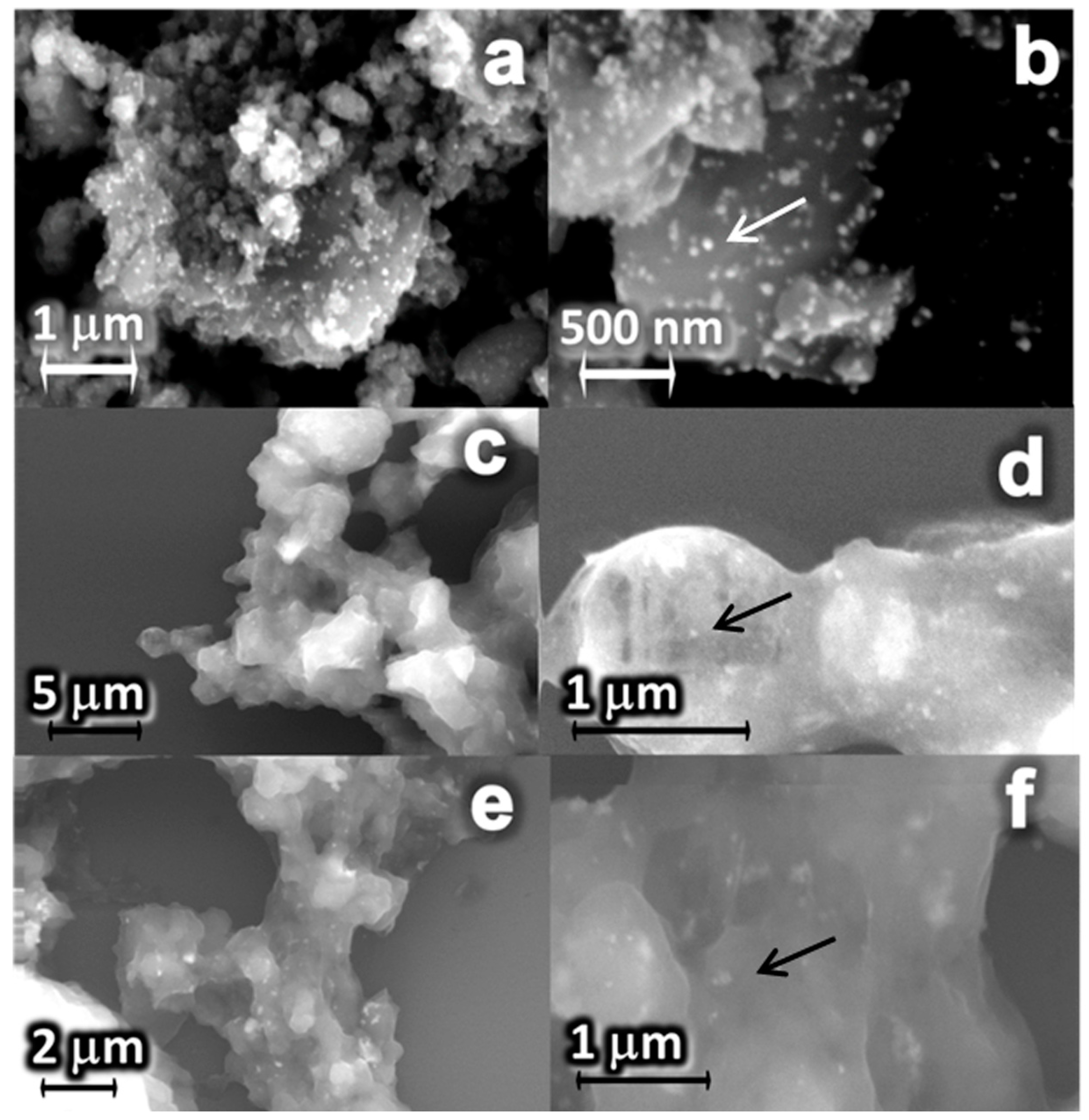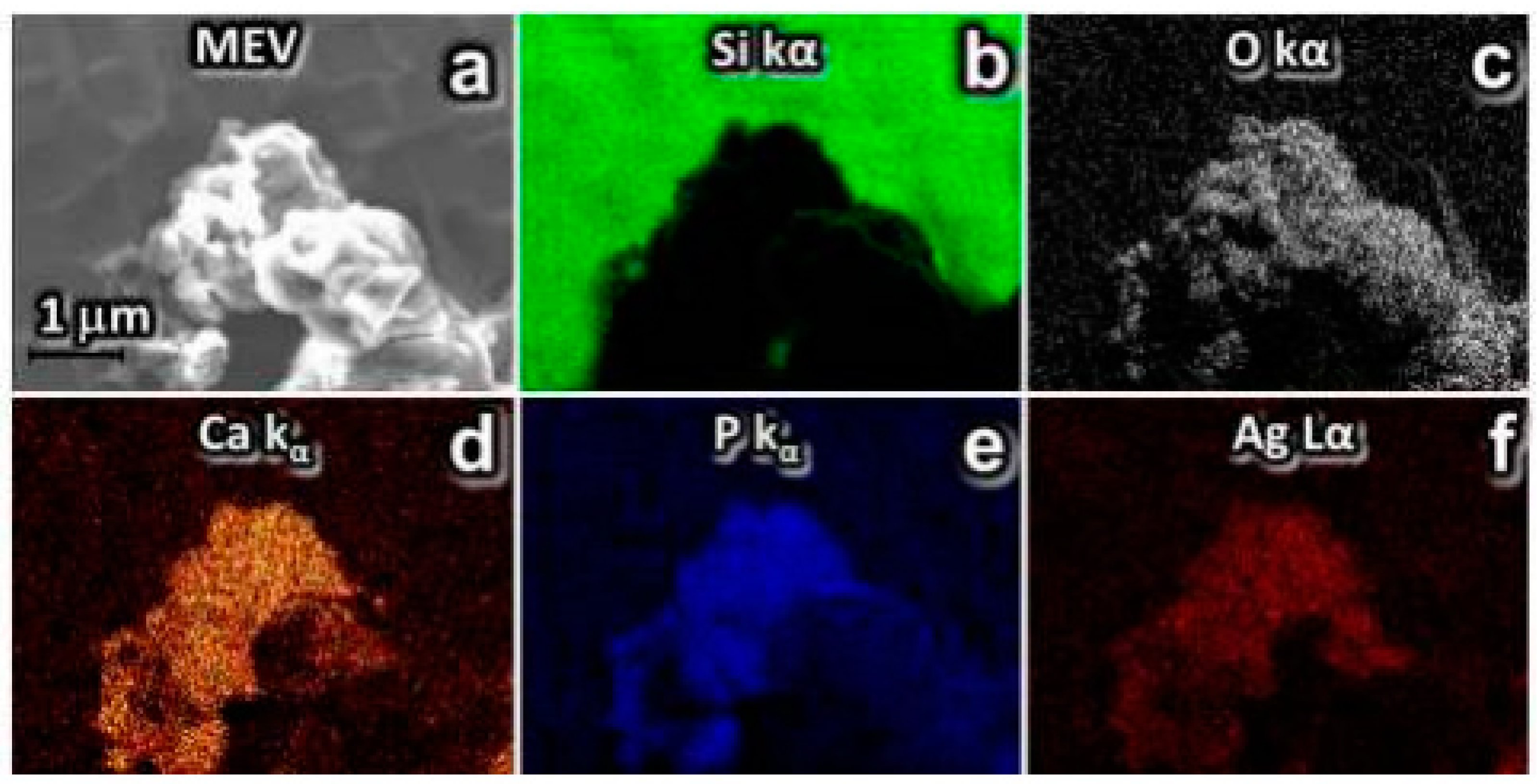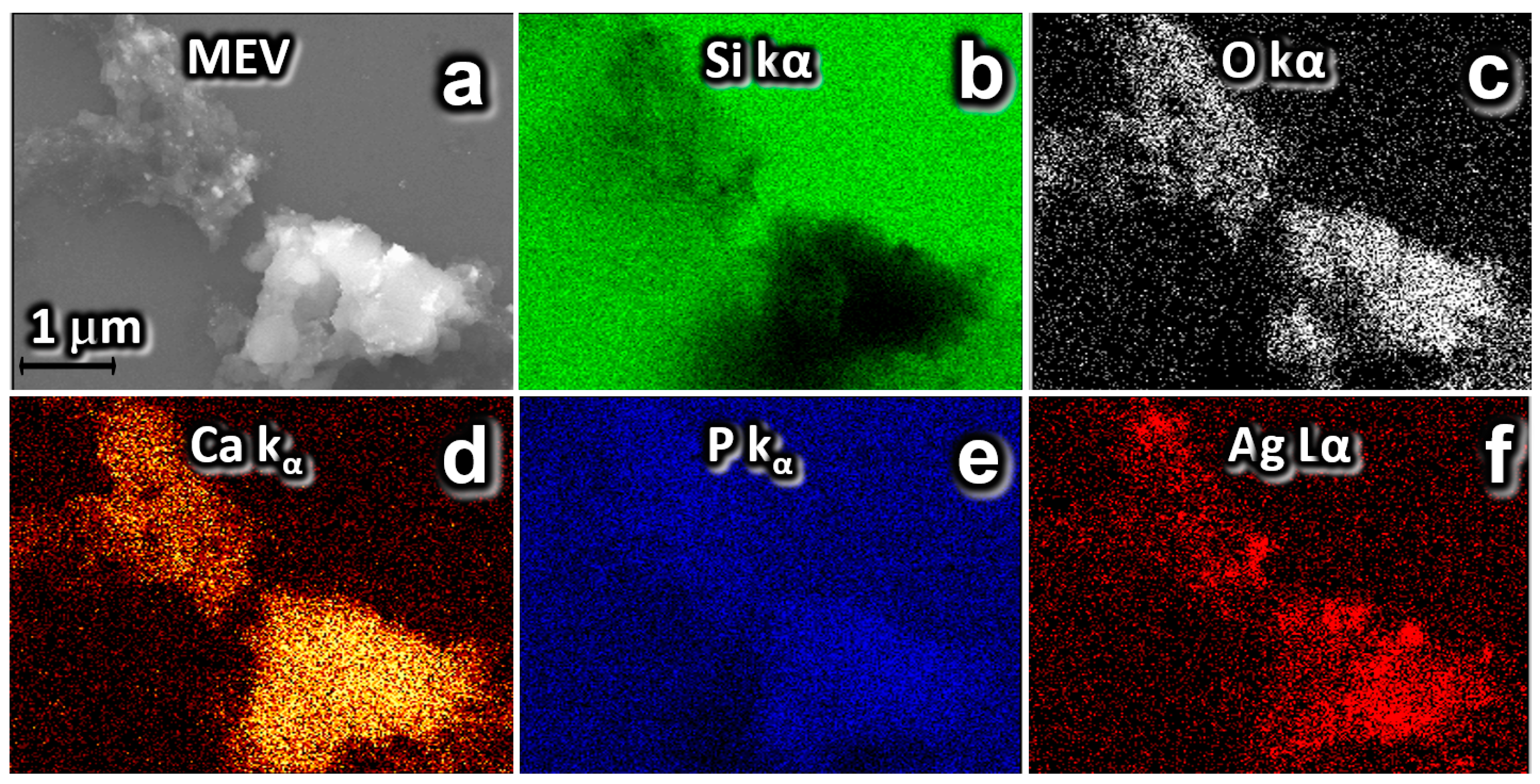Nanosynthesis of Silver-Calcium Glycerophosphate: Promising Association against Oral Pathogens
Abstract
1. Introduction
2. Results
2.1. Synthesis and Characterization of Ag-CaGP Nanocomposites
2.2. Minimum Inhibitory Concentration
2.3. Determination of Ag+ Concentration
3. Discussion
4. Materials and Methods
4.1. Synthesis of Silver-Calcium Glycerophosphate (Ag/CaGP) Nanocomposites
4.2. Characterization of Ag-CaGP Nanocomposites
4.3. Minimum Inhibitory Concentration (MIC)
4.4. Determination of Ag+ Concentration
5. Conclusions
Supplementary Materials
Author Contributions
Funding
Conflicts of Interest
References
- De Oliveira, J.F.; Cardoso, M.B. Partial aggregation of silver nanoparticles induced by capping and reducing agents competition. Langmuir ACS J. Surf. Colloids 2014, 30, 4879–4886. [Google Scholar] [CrossRef] [PubMed]
- Zandparsa, R. Latest biomaterials and technology in dentistry. Dent. Clin. N. Am. 2014, 58, 113–134. [Google Scholar] [CrossRef] [PubMed]
- Perez-Diaz, M.A.; Boegli, L.; James, G.; Velasquillo, C.; Sanchez-Sanchez, R.; Martinez-Martinez, R.E.; Martinez-Castanon, G.A.; Martinez-Gutierrez, F. Silver nanoparticles with antimicrobial activities against Streptococcus mutans and their cytotoxic effect. Mater. Sci. Eng. C Mater. Biol. Appl. 2015, 55, 360–366. [Google Scholar] [CrossRef] [PubMed]
- Besinis, A.; De Peralta, T.; Handy, R.D. The antibacterial effects of silver, titanium dioxide and silica dioxide nanoparticles compared to the dental disinfectant chlorhexidine on Streptococcus mutans using a suite of bioassays. Nanotoxicology 2014, 8, 1–16. [Google Scholar] [CrossRef] [PubMed]
- Li, Q.; Mahendra, S.; Lyon, D.Y.; Brunet, L.; Liga, M.V.; Li, D.; Alvarez, P.J. Antimicrobial nanomaterials for water disinfection and microbial control: Potential applications and implications. Water Res. 2008, 42, 4591–4602. [Google Scholar] [CrossRef] [PubMed]
- Kim, K.J.; Sung, W.S.; Suh, B.K.; Moon, S.K.; Choi, J.S.; Kim, J.G.; Lee, D.G. Antifungal activity and mode of action of silver nano-particles on Candida albicans. Biomet. Int. J. Role Met. Ions Biol. Biochem. Med. 2009, 22, 235–242. [Google Scholar] [CrossRef] [PubMed]
- Kim, J.S.; Kuk, E.; Yu, K.N.; Kim, J.H.; Park, S.J.; Lee, H.J.; Kim, S.H.; Park, Y.K.; Park, Y.H.; Hwang, C.Y.; et al. Antimicrobial effects of silver nanoparticles. Nanomedicine 2007, 3, 95–101. [Google Scholar] [CrossRef] [PubMed]
- Monteiro, D.R.; Silva, S.; Negri, M.; Gorup, L.F.; de Camargo, E.R.; Oliveira, R.; Barbosa, D.B.; Henriques, M. Silver nanoparticles: Influence of stabilizing agent and diameter on antifungal activity against Candida albicans and Candida glabrata biofilms. Lett. Appl. Microbiol. 2012, 54, 383–391. [Google Scholar] [CrossRef] [PubMed]
- Metwalli, K.H.; Khan, S.A.; Krom, B.P.; Jabra-Rizk, M.A. Streptococcus mutans, Candida albicans, and the human mouth: A sticky situation. PLoS Pathog. 2013, 9, e1003616. [Google Scholar] [CrossRef] [PubMed]
- Lemos, J.A.; Quivey, R.G., Jr.; Koo, H.; Abranches, J. Streptococcus mutans: A new Gram-positive paradigm? Microbiology 2013, 159, 436–445. [Google Scholar] [CrossRef] [PubMed]
- Falsetta, M.L.; Klein, M.I.; Lemos, J.A.; Silva, B.B.; Agidi, S.; Scott-Anne, K.K.; Koo, H. Novel antibiofilm chemotherapy targets exopolysaccharide synthesis and stress tolerance in Streptococcus mutans to modulate virulence expression in vivo. Antimicrob. Agents Chemother. 2012, 56, 6201–6211. [Google Scholar] [CrossRef] [PubMed]
- Rouabhia, M.; Chmielewski, W. Diseases Associated with Oral Polymicrobial Biofilms. Open Mycol. J. 2012, 6, 27–32. [Google Scholar]
- Barbieri, D.S.V.; Vicente, V.A.; Fraiz, F.C.; Lavoranti, O.J.; Svidzinski, T.I.E.; Pinheiro, R.L. Analysis of the in vitro adherence of Streptococcus mutans and Candida albicans. Braz. J. Microbiol. 2007, 38, 624–631. [Google Scholar] [CrossRef]
- Jarosz, L.M.; Deng, D.M.; van der Mei, H.C.; Crielaard, W.; Krom, B.P. Streptococcus mutans competence-stimulating peptide inhibits Candida albicans hypha formation. Eukaryot. Cell 2009, 8, 1658–1664. [Google Scholar] [CrossRef] [PubMed]
- Monteiro, D.R.; Gorup, L.F.; Silva, S.; Negri, M.; de Camargo, E.R.; Oliveira, R.; Barbosa, D.B.; Henriques, M. Silver colloidal nanoparticles: Antifungal effect against adhered cells and biofilms of Candida albicans and Candida glabrata. Biofouling 2011, 27, 711–719. [Google Scholar] [CrossRef] [PubMed]
- Monteiro, D.R.; Gorup, L.F.; Takamiya, A.S.; Ruvollo-Filho, A.C.; de Camargo, E.R.; Barbosa, D.B. The growing importance of materials that prevent microbial adhesion: Antimicrobial effect of medical devices containing silver. Int. J. Antimicrob. Agents 2009, 34, 103–110. [Google Scholar] [CrossRef] [PubMed]
- Lynch, R.J.; ten Cate, J.M. Effect of calcium glycerophosphate on demineralization in an in vitro biofilm model. Caries Res. 2006, 40, 142–147. [Google Scholar] [CrossRef] [PubMed]
- Bowen, W.H. The cariostatic effect of calcium glycerophosphate in monkeys. Caries Res. 1972, 6, 43–51. [Google Scholar] [CrossRef] [PubMed]
- Grenby, T.H. Trials of 3 organic phosphorus-containing compounds as protective agents against dental caries in rats. J. Dent. Res. 1973, 52, 454–461. [Google Scholar] [CrossRef] [PubMed]
- Duke, S.A.; Rees, D.A.; Forward, G.C. Increased plaque calcium and phosphorus concentrations after using a calcium carbonate toothpaste containing calcium glycerophosphate and sodium monofluorophosphate. Pilot study. Caries Res. 1979, 13, 57–59. [Google Scholar] [CrossRef] [PubMed]
- Nordbo, H.; Rolla, G. Desorption of salivary proteins from hydroxyapatite by phytic acid and glycerophosphate and the plaque-inhibiting effect of the two compounds in vivo. J. Dent. Res. 1972, 51, 800–811. [Google Scholar] [CrossRef] [PubMed]
- Grenby, T.H.; Bull, J.M. Use of high-performance liquid chromatography techniques to study the protection of hydroxylapatite by fluoride and glycerophosphate against demineralization in vitro. Caries Res. 1980, 14, 221–232. [Google Scholar] [CrossRef] [PubMed]
- Naylor, M.N.; Glass, R.L. A three-year clinical trial of a calcium carbonate dentifrice containing calcium glycerophosphate and sodium monofluorophosphate. Caries Res. 1979, 13, 39–46. [Google Scholar] [CrossRef] [PubMed]
- Mainwaring, P.J.; Naylor, M.N. A four-year clinical study to determine the caries-inhibiting effect of calcium glycerophosphate and sodium fluoride in calcium carbonate base dentifrices containing sodium monofluorophosphate. Caries Res. 1983, 17, 267–276. [Google Scholar] [CrossRef] [PubMed]
- do Amaral, J.G.; Sassaki, K.T.; Martinhon, C.C.; Delbem, A.C. Effect of low-fluoride dentifrices supplemented with calcium glycerophosphate on enamel demineralization in situ. Am. J. Dent. 2013, 26, 75–80. [Google Scholar] [PubMed]
- Zaze, A.C.; Dias, A.P.; Amaral, J.G.; Miyasaki, M.L.; Sassaki, K.T.; Delbem, A.C. In situ evaluation of low-fluoride toothpastes associated to calcium glycerophosphate on enamel remineralization. J. Dent. 2014, 42, 1621–1625. [Google Scholar] [CrossRef] [PubMed]
- Ghosh, S.K.; Pal, T. Interparticle coupling effect on the surface plasmon resonance of gold nanoparticles: From theory to applications. Chem. Rev. 2007, 107, 4797–4862. [Google Scholar] [CrossRef] [PubMed]
- Inoue, M.; In, Y.; Ishida, T. Calcium binding to phospholipid: Structural study of calcium glycerophosphate. J. Lipid Res. 1992, 33, 985–994. [Google Scholar] [PubMed]
- Miranda, M.; Fernandez, A.; Lopez-Esteban, S.; Malpartida, F.; Moya, J.S.; Torrecillas, R. Ceramic/metal biocidal nanocomposites for bone-related applications. J. Mater. Sci. Mater. Med. 2012, 23, 1655–1662. [Google Scholar] [CrossRef] [PubMed]
- Pal, S.; Tak, Y.K.; Song, J.M. Does the antibacterial activity of silver nanoparticles depend on the shape of the nanoparticle? A study of the Gram-negative bacterium Escherichia coli. Appl. Environ. Microbiol. 2007, 73, 1712–1720. [Google Scholar] [CrossRef] [PubMed]
- Bradford, A.; Handy, R.D.; Readman, J.W.; Atfield, A.; Mühling, M. Impact of silver nanoparticle contamination on the genetic diversity of natural bacterial assemblages in estuarine sediments. Environ. Sci. Technol. 2009, 43, 4530–4536. [Google Scholar] [CrossRef] [PubMed]
- Duran, N.; Duran, M.; de Jesus, M.B.; Seabra, A.B.; Favaro, W.J.; Nakazato, G. Silver nanoparticles: A new view on mechanistic aspects on antimicrobial activity. Nanomedicine 2016, 12, 789–799. [Google Scholar] [CrossRef] [PubMed]
- Le Ouay, B.; Stellacci, F. Antibacterial activity of silver nanoparticles: A surface science insight. Nanotoday 2015, 10, 339–354. [Google Scholar] [CrossRef]
- Lok, C.N.; Zou, T.; Zhang, J.J.; Lin, I.W.; Che, C.M. Controlled-release systems for metal-based nanomedicine: Encapsulated/self-assembled nanoparticles of anticancer gold(III)/platinum(II) complexes and antimicrobial silver nanoparticles. Adv. Mater. 2014, 26, 5550–5557. [Google Scholar] [CrossRef] [PubMed]
- Lok, C.N.; Ho, C.M.; Chen, R.; He, Q.Y.; Yu, W.Y.; Sun, H.; Tam, P.K.; Chiu, J.F.; Che, C.M. Proteomic analysis of the mode of antibacterial action of silver nanoparticles. J. Proteom. Res. 2006, 5, 916–924. [Google Scholar] [CrossRef] [PubMed]
- Hou, W.C.; Stuart, B.; Howes, R.; Zepp, R.G. Sunlight-driven reduction of silver ions by natural organic matter: Formation and transformation of silver nanoparticles. Environ. Sci. Technol. 2013, 47, 7713–7721. [Google Scholar] [CrossRef] [PubMed]
- Onodera, A.; Nishiumi, F.; Kakiguchi, K.; Tanaka, A.; Tanabe, N.; Honma, A.; Yayama, K.; Yoshioka, Y.; Nakahira, K.; Yonemura, S.; et al. Short-term changes in intracellular ROS localisation after the silver nanoparticles exposure depending on particle size. Toxicol. Rep. 2015, 2, 574–579. [Google Scholar] [CrossRef] [PubMed]
- Agnihotri, S.; Mukherji, S.; Mukherji, S. Immobilized silver nanoparticles enhance contact killing and show highest efficacy: Elucidation of the mechanism of bactericidal action of silver. Nanoscale 2013, 5, 7328–7340. [Google Scholar] [CrossRef] [PubMed]
- Tolaymat, T.M.; El Badawy, A.M.; Genaidy, A.; Scheckel, K.G.; Luxton, T.P.; Suidan, M. An evidence-based environmental perspective of manufactured silver nanoparticle in syntheses and applications: A systematic review and critical appraisal of peer-reviewed scientific papers. Sci. Total Environ. 2010, 408, 999–1006. [Google Scholar] [CrossRef] [PubMed]
- Solomon, S.D.; Bahadory, M.; Jeyarajasingam, A.V.; Rutkowsky, S.A.; Boritz, C. Synthesis and Study of Silver Nanoparticles. J. Chem. Educ. 2007, 84, 322–325. [Google Scholar]
- Malanovic, N.; Lohner, K. Gram-positive bacterial cell envelopes: The impact on the activity of antimicrobial peptides. Biochim. Biophys. Acta 2016, 1858, 936–946. [Google Scholar] [CrossRef] [PubMed]
- Loffler, J.; Einsele, H.; Hebart, H.; Schumacher, U.; Hrastnik, C.; Daum, G. Phospholipid and sterol analysis of plasma membranes of azole-resistant Candida albicans strains. FEMS Microbiol. Lett. 2000, 185, 59–63. [Google Scholar] [CrossRef]
- Lara, H.H.; Romero-Urbina, D.G.; Pierce, C.; Lopez-Ribot, J.L.; Arellano-Jimenez, M.J.; Jose-Yacaman, M. Effect of silver nanoparticles on Candida albicans biofilms: An ultrastructural study. J. Nanobiotechnol. 2015, 13, 91. [Google Scholar] [CrossRef] [PubMed]
- Stoimenov, P.K.; Klinger, R.L.; Marchin, G.L.; Klabunde, K.J. Metal Oxide Nanoparticles as Bactericidal Agents. Langmuir ACS J. Surf. Colloids 2002, 18, 6679–6686. [Google Scholar] [CrossRef]
- Hamouda, T.; Baker, J.R., Jr. Antimicrobial mechanism of action of surfactant lipid preparations in enteric Gram-negative bacilli. J. Appl. Microbiol. 2000, 89, 397–403. [Google Scholar] [CrossRef] [PubMed]
- Lynch, R.J. Calcium glycerophosphate and caries: A review of the literature. Int. Dent. J. 2004, 54, 310–314. [Google Scholar] [CrossRef] [PubMed]
- Turkevich, J.; Stevenson, P.C.; Hillier, J. A study of the nucleation and growth processes in the synthesis of colloidal gold. Discuss. Faraday Soc. 1951, 11, 55–75. [Google Scholar] [CrossRef]
- Gorup, L.F.; Longo, E.; Leite, E.R.; Camargo, E.R. Moderating effect of ammonia on particle growth and stability of quasi-monodisperse silver nanoparticles synthesized by the Turkevich method. J. Colloid Interface Sci. 2011, 360, 355–358. [Google Scholar] [CrossRef] [PubMed]




| GROUP | Ag %/CaGP Form | Solvent | MIC (µg AgCaGP mL−1/µg Ag mL−1) | µg Ag+/mL | |
|---|---|---|---|---|---|
| C. albicans | S. mutans | ||||
| B1 | 1/M | I | >1600/>16 | >1600/>16 | 2.83 |
| B2 | 1/N | I | 400–1600/0.40–16 | >1600/>16 | 4.46 |
| B3 | 10/M | I | 400–800/40–80 | >1600/>16 | 10.81 |
| B4 | 10/N | I | 100–200/10–20 | >1600/>16 | 63.34 |
| B5 | 1/M | W | >1600/>16 | >1600/>16 | 0.44 |
| B6 | 1/N | W | >1600/>16 | >1600/>16 | 2.76 |
| B7 | 10/M | W | >1600/>16 | >1600/>16 | 5.97 |
| B8 | 10/N | W | >1600/>16 | >1600/>16 | 15.63 |
| C1 | 1/M | W | 156.2–312.5/1.56–3.12 | 1250/12.5 | 305.43 |
| C2 | 1/N | W | 156.2–312.5/1.56–3.12 | 1250/12.5 | 168.14 |
| C3 | 10/M | W | 39.0/3.9 | 312.5–625/31.2–62.5 | 506.73 |
| C4 | 10/N | W | 19.5–39.0/1.9–3.9 | 156.2–312.5/15.6–31.2 | 487.95 |
| Controls | MIC | Ag+ | |
|---|---|---|---|
| C. albicans | S. mutans | ||
| AgNP (Na3C6H5O7) | 7.8 | 250 | 107.2 |
| AgNP (NaBH4) | 62.5 | 125 | 576.2 |
| AgNO3 | 5.3 | 21.2 | - |
| CaGP-nano | >5000 | >5000 | - |
| CaGP-commercial | >5000 | >5000 | - |
| Na3C6H5O7+NH-PM | >400 | >400 | - |
| NaBH4+NH-PM | >1500 | >1500 | - |
© 2018 by the authors. Licensee MDPI, Basel, Switzerland. This article is an open access article distributed under the terms and conditions of the Creative Commons Attribution (CC BY) license (http://creativecommons.org/licenses/by/4.0/).
Share and Cite
Fernandes, G.L.; Delbem, A.C.B.; Do Amaral, J.G.; Gorup, L.F.; Fernandes, R.A.; De Souza Neto, F.N.; Souza, J.A.S.; Monteiro, D.R.; Hunt, A.M.A.; Camargo, E.R.; et al. Nanosynthesis of Silver-Calcium Glycerophosphate: Promising Association against Oral Pathogens. Antibiotics 2018, 7, 52. https://doi.org/10.3390/antibiotics7030052
Fernandes GL, Delbem ACB, Do Amaral JG, Gorup LF, Fernandes RA, De Souza Neto FN, Souza JAS, Monteiro DR, Hunt AMA, Camargo ER, et al. Nanosynthesis of Silver-Calcium Glycerophosphate: Promising Association against Oral Pathogens. Antibiotics. 2018; 7(3):52. https://doi.org/10.3390/antibiotics7030052
Chicago/Turabian StyleFernandes, Gabriela Lopes, Alberto Carlos Botazzo Delbem, Jackeline Gallo Do Amaral, Luiz Fernando Gorup, Renan Aparecido Fernandes, Francisco Nunes De Souza Neto, José Antonio Santos Souza, Douglas Roberto Monteiro, Alessandra Marçal Agostinho Hunt, Emerson Rodrigues Camargo, and et al. 2018. "Nanosynthesis of Silver-Calcium Glycerophosphate: Promising Association against Oral Pathogens" Antibiotics 7, no. 3: 52. https://doi.org/10.3390/antibiotics7030052
APA StyleFernandes, G. L., Delbem, A. C. B., Do Amaral, J. G., Gorup, L. F., Fernandes, R. A., De Souza Neto, F. N., Souza, J. A. S., Monteiro, D. R., Hunt, A. M. A., Camargo, E. R., & Barbosa, D. B. (2018). Nanosynthesis of Silver-Calcium Glycerophosphate: Promising Association against Oral Pathogens. Antibiotics, 7(3), 52. https://doi.org/10.3390/antibiotics7030052






